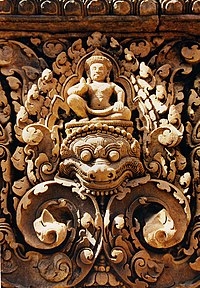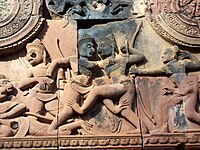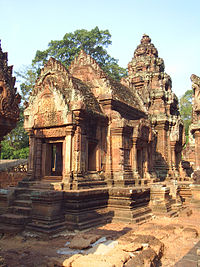- Back to Home »
- Banteay Srei Temple
Banteay Srei or Banteay Srey (Khmer: ប្រាសាទបន្ទាយស្រី) is a 10th-century Cambodian temple dedicated to the Hindu god Shiva. Located in the area of Angkor in Cambodia. It lies near the hill of Phnom Dei, 25 km (16 mi) north-east of the main group of temples that once belonged to the medieval capitals of Yasodharapura and Angkor Thom.[1] Banteay Srei is built largely of red sandstone,
a medium that lends itself to the elaborate decorative wall carvings
which are still observable today. The buildings themselves are miniature
in scale, unusually so when measured by the standards of Angkorian
construction. These factors have made the temple extremely popular with
tourists, and have led to its being widely praised as a "precious gem",
or the "jewel of Khmer art."[2]
History
Foundation and dedication
A brief study on Chola-built temples in Kampuchea (Cambodia)
With this good Chola-Khamer relationship the Saivite Priests, Traders and Stone Sculpturers from Chola country gradually settled in the region of Angkor the capital city of the Khamer emperor Suriyavarman - 1. During this period an old Siva Temple at 'Banteay Srei' 30 km from the Angkor Wat temple in Cambodia was 'expanded and new sections were added to an existing Siva temple' evidently by the Chola forces and re-dedicated to God Siva, with the new name "Thiribuvanamahadeva Temple" after Rajendra Chola's own mother's name the "Thiribhuvanamahadevi".
In this temple in its second enclosure, on the Gopura over main entrance we see an image of Nadarajah represented with eight hands but not in the same style as the Nadarajah images in the Tamil Nadu with left leg lifted and with four hands. In the lower panel beneath the Nadarajah image on its right side we see an image of a Drummer playing the drums to the beat of the Dance of God Siva depicted as Nadarajah, and on the left we see an image "visibly and positively confirmed" as that of the Kaaraikaal Ammaiyar of the Chola Country being one of the 63 - Tamil Saiva Saints of Tamil Nadu. This Panel undoubtedly was carved by a Tamil Sculpturer apparently from Chola country in Tamil Nadu.
The Image of the Stone Panel at 'Banteay Srei' Siva Temple in Angkor, Cambodia, with the images of Nadarajah & Kaaraikkaal Ammaiyar can be reached and viewed on the following URL. (Enlarge this Image on your Computer to see the image of Kaaraikaal Ammaiyaar clearly with her ghostly Face and lean body with Ribs showing and holding a mango fruit in the right hand, an image of Kaaraikkaal Ammaiyaar comparable with the other images of her found in Tamil Nadu and in Polonnaruwa in Sri Lanka.
http://upload.wikimedia.org/wikipedi...lintelsrei.JPG
Expansion and rededication
Bantãy Srĕi was subject to further expansion and rebuilding work in the eleventh century.[8]:96 At some point it came under the control of the king and had its original dedication changed; the inscription K 194 from Phnoṃ Sandak, dated Monday, the 14th or 28 July 1119 A.D. records (line B 13) the temple being given to the priest Divākarapaṇḍita and being rededicated to Śiva.[9] It remained in use at least until the fourteenth century according to the last known inscription K 569, dated Thursday, 8 August 1303 A.D.[10]Restoration
The temple was rediscovered only in 1914, and was the subject of a celebrated case of art theft when André Malraux stole four devatas in 1923 (he was soon arrested and the figures returned).[11] The incident stimulated interest in the site, which was cleared the following year, and in the 1930s Banteay Srei was restored through the first important use of anastylosis at Angkor whereby a ruined building or monument is restored using the original architectural elements to the greatest degree possible. Until the discovery of the foundation stela in 1936, it had been assumed that the extreme decoration indicated a later date than was in fact the case.[12] To prevent the site from water damage, the joint Cambodian-Swiss Banteay Srei Conservation Project installed a drainage system between 2000 and 2003.[13] Measures were also taken to prevent damage to the temples walls from nearby trees.[14] Unfortunately, the temple has been ravaged by pilfering and vandalism. When toward the end of the 20th century authorities removed some original statues and replaced them with concrete replicas, looters took to attacking the replicas. A statue of Shiva and his shakti Uma, removed to the National Museum in Phnom Penh for safekeeping, was assaulted in the museum itself.[15]Materials and style
Banteay Srei is built largely of a hard red sandstone that can be carved like wood.[16] Brick and laterite were used only for the enclosure walls and some structural elements. The temple is known for the beauty of its sandstone lintels and pediments.A pediment is the roughly triangular space above a rectangular doorway or openings. At Banteay Srei, pediments are relatively large in comparison to the openings below, and take a sweeping gabled shape. For the first time in the history of Khmer architecture, whole scenes of mythological subject-matter are depicted on the pediments.
A lintel is a horizontal beam spanning the gap between two posts. Some lintels serve a structural purpose, serving to support the weight of the superstructure, while others are purely decorative in purpose. The lintels at Banteay Srei are beautifully carved, rivalling those of the 9th century Preah Ko style in quality.
The site
The site consists of three concentric rectangular enclosures constructed on an east–west axis. A causeway situated on the axis leads from an outer gopura, or gate, to the third or outermost of the three enclosures. The inner enclosure contains the sanctuary, consisting of an entrance chamber and three towers, as well as two buildings conventionally referred to as libraries.The outer gopura
The gopura is all that remains of the outer wall surrounding the town of Isvapura. The wall is believed to have measured approximately 500 m square, and may have been constructed of wood. The gopura's eastern pediment shows Indra, who was associated with that direction, mounted on his three-headed elephant Airavata.[18] The 67 m causeway with the remains of corridors on either side connects the gopura with the third enclosure. North and south of this causeway are galleries with a north–south orientation.The third (outer) enclosure
The second enclosure
The first (inner) enclosure
Between the gopuras on the collapsed inner wall are the buildings of the inner enclosure: a library in the south-east corner and another in the north-east corner, and in the centre the sanctuary set on a T-shaped platform 0.9 m high. Besides being the most extravagantly decorated parts of the temple, these have also been the most successfully restored (helped by the durability of their sandstone and their small scale). In 2010, the first enclosure is open to visitors again, but the inner temples are roped off and inaccessible.The libraries
The two libraries are of brick, laterite and sandstone. Each library has two pediments, one on the eastern side and one on the western. According to Maurice Glaize, the four library pediments, "representing the first appearance of tympanums with scenes, are works of the highest order. Superior in composition to any which followed, they show true craftsmanship in their modelling in a skilful blend of stylisation and realism."[23]The west-facing pediment on southern library shows Śiva again seated on the summit of Mount Kailāsa. He is looking to his left at the god of love Kāma, who is aiming an arrow at him. Umā sits to Śiva's right; he is handing her a chain of beads. The slopes of the mountain are crowded with other beings, again arranged in a strict hierarchy from top to bottom. Just under Śiva sits a group of bearded wise men and ascetics, under whom the second tier is occupied by the mythological beings with the heads of animals and the bodies of humans; the lowest tier belongs the common people, who mingle sociably with tame deer and a large gentle bull. According to the legend, Kāma fired an arrow at Śiva in order to cause Śiva to take an interest in Umā. Śiva, however, was greatly angered by this provocation, and punished Kāma by gazing upon him with his third eye, frying Kāma to cinders.[24]
The west-facing pediment on the southern library depicts Kṛṣṇa slaying his wicked uncle Kamsa.[25]
The sanctuary
ms.
ប្រភព៖ Tourism Cambodia












